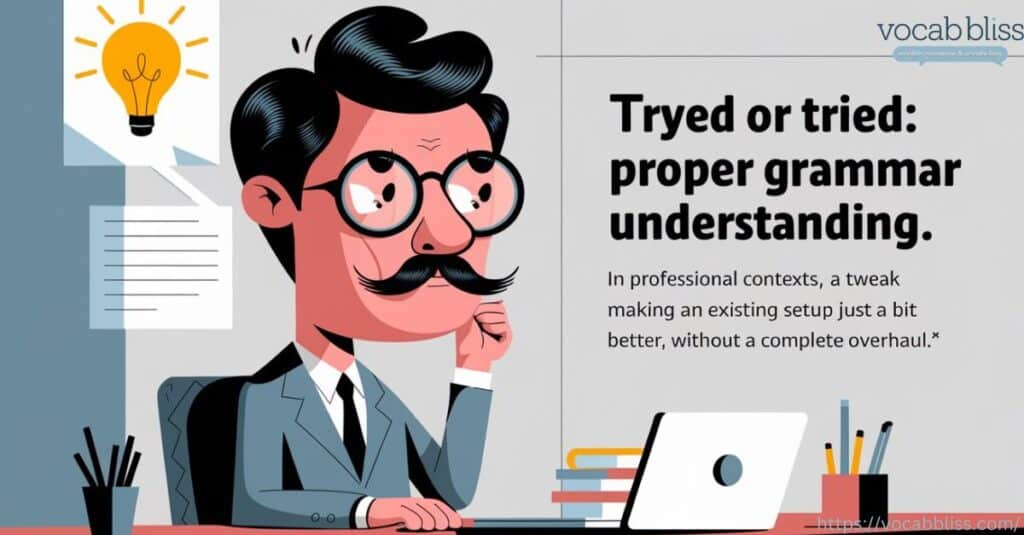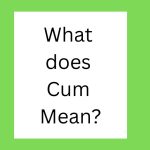When it comes to spelling and grammar, even the smallest mistake can change the meaning of a word or make writing seem less professional. One of the most common errors in English is the confusion between “tryed or tried”.
These variations might seem trivial, but understanding why only one is correct can significantly improve your grasp of English grammar and spelling rules.This article will break down everything you need to know about “tryed or tried” the rules of forming the past tense of verbs, and tips for remembering the correct spelling. By the end, you’ll be ready to use “tried” confidently in both written and spoken English.
Joining a Blooket join game is simple but powerful. When you enter a game, you get to compete with classmates in real-time. Teachers share a special code, called a “join code,” allowing anyone in class to participate. This makes learning more interactive and fun.
Understanding the Root Word: “Try”
Before we dig into the differences between “tried” and “tryed,” it helps to understand the base verb: try. In English, “try” means to make an attempt or put effort into accomplishing something. Here are some simple examples:
- I try to exercise every morning.
- She tries new recipes every week.
Verb Forms of “Try” in English Grammar
The verb “try” is conjugated in different forms, depending on the tense and context. Here’s a quick look at how “try” changes:
| Verb Form | Example | Usage |
|---|---|---|
| Base form | Try | Used in present tense (I try) |
| Third person | Tries | Used with “he/she/it” (She tries) |
| Present participle | Trying | Used in continuous tenses (I am trying) |
| Past tense | Tried | Used in past simple (I tried) |
| Past participle | Tried | Used with perfect tenses (I have tried) |
As you can see, the correct past tense and past participle form of “try” is “tried,” not “tryed.”
Tried vs. Tryed: Breaking Down the Difference
Tried: Definition and Usage
“Tried” is the universally accepted form of the past tense and past participle of the verb “try.” According to English spelling rules, when a verb ends with a consonant followed by “y,” the “y” changes to an “i” before adding “ed” for the past tense. This rule is part of basic English grammar and applies to many verbs, not just “try.”
Examples of “Tried” in a Sentence
To see “tried” in action, here are some examples in different contexts:
- She tried her best to solve the problem.
- They tried the new restaurant downtown.
- I have tried to reach you several times this week.

In all these sentences, “tried” is correctly used as the past tense and past participle form of “try.”
Tryed: Why It’s Incorrect
“Tryed” is a common misspelling of “tried,” likely because English spelling rules can be confusing. However, tryed does not follow English grammar rules for forming past tense verbs. Adding “ed” directly to “try” without changing the “y” to “i” does not produce a correct word.
Here’s why this happens:
- In verbs ending with a consonant followed by “y,” English rules state that you change the y to i before adding ed.
- The pattern is seen in words like “cry” (cried), “deny” (denied), and “reply” (replied).
Key Tip: If you’re ever unsure whether to use “tryed” or “tried,” remember that “tryed” isn’t a valid English word. Only “tried” is correct.
Understanding English Spelling Rules for Verbs Ending in “Y”
To understand why “tried” is correct and “tryed” isn’t, let’s explore a key spelling rule in English:
Basic Rule: Changing “Y” to “I” in Past Tense
For verbs that end in “y” preceded by a consonant, change the “y” to “i” before adding “ed” for the past tense or past participle. This rule keeps the pronunciation of the word clear and prevents awkward spellings.
Examples of Similar Verbs:
Here’s a quick list of verbs following the same rule:
| Base Form | Correct Past Tense | Incorrect Past Tense |
|---|---|---|
| Cry | Cried | Cryed |
| Reply | Replied | Replyed |
| Apply | Applied | Applyed |
| Deny | Denied | Denyed |
| Try | Tried | Tryed |
These examples show that “tried” follows the correct rule of verb formation, while “tryed” doesn’t.
Why English Has This Rule
The “y to i” rule makes the English language sound smoother. Imagine how “cryed” or “tryed” would look and sound—it doesn’t flow as naturally. Following this spelling rule maintains consistency across similar verbs, making writing easier to read and understand.
Tips to Remember the Correct Spelling of “Tried”
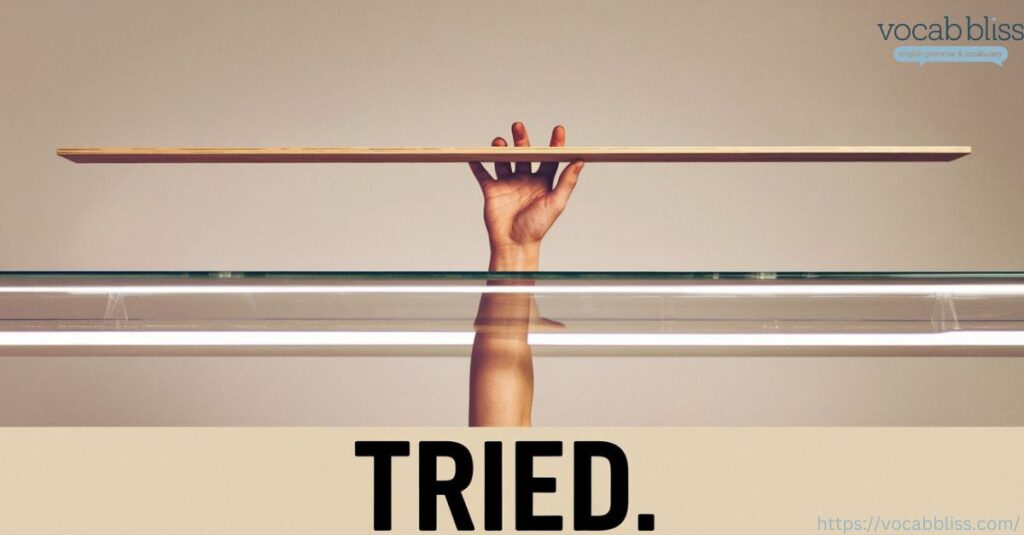
Mastering this spelling rule doesn’t have to be difficult. Here are some tips to make sure you remember that “tried” is the correct form:
Mnemonic Tricks
- Remember the rhyme: When in doubt, swap the “y” out! If the verb ends with “y” preceded by a consonant, change “y” to “i” before adding “ed.”
- Think of other verbs with similar endings: When you see a verb ending in “y” like “cry” or “reply,” remember that it follows the same pattern as “try.”
Pattern Recognition
With practice, spotting patterns becomes second nature. Look at verbs in everyday language to see if they end in “y.” If so, think about whether the verb changes in the past tense by adding “ed” directly, or if the “y” needs to become an “i” first.
Practice Sentences
To lock in your knowledge, try writing sentences with the correct form of “tried” every day. For example:
- I tried learning a new language.
- They tried different methods to fix the issue.
- We tried the recipe with extra spices.
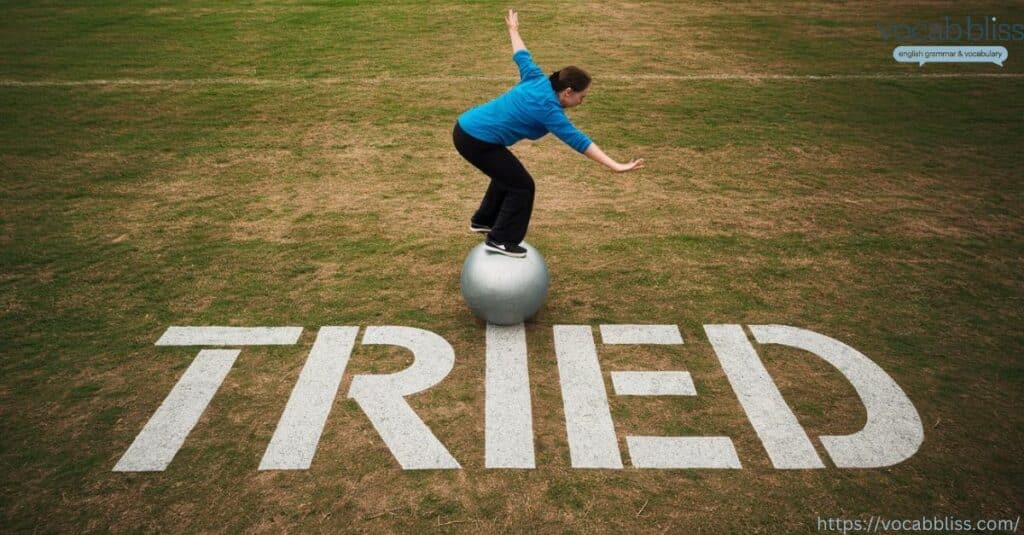
By practicing regularly, you’ll quickly get comfortable with “tried” over “tryed.”
Examples of “Tried” in Everyday Sentences
Seeing “tried” used in a variety of contexts can help reinforce its proper usage. Here are examples in everyday language, covering formal, informal, written, and spoken English:
- Formal Use: The committee tried several approaches before deciding on a solution.
- Informal Use: I tried calling you last night, but you didn’t pick up.
- Writing Context: He has tried many times to improve his skills in painting.
- Spoken English: Have you tried this new dessert? It’s amazing!
By practicing and observing how “tried” appears in different types of sentences, you’ll develop writing confidence in using this word correctly.
Common Misspellings & Why They Happen
Even proficient English speakers can make spelling mistakes, especially with tricky words like “tried.” Here are some reasons why “tryed” often gets mistaken as correct:
- Overgeneralization: People may assume that adding “ed” to a verb’s base form is always correct.
- Inconsistent Rules: English has irregular spelling rules, making it easy to overlook exceptions like “verbs ending in y.”
- Typing Errors: When typing quickly, some may type “tryed” by mistake and not notice it’s incorrect.
Spell-check tools in most word processors can catch these errors, but understanding the rule behind “tried” will help you avoid the mistake even without digital assistance.
Quick Reference Table: Tryed vs Tried
Here’s a side-by-side comparison to help you distinguish between “tried” and “tryed” easily:
| Word | Correct/Incorrect | Reason | Example Sentence |
|---|---|---|---|
| Tried | Correct | Follows the “y to i” rule | She tried to call you last night. |
| Tryed | Incorrect | Does not follow standard spelling rules | I tryed to finish the project. (wrong) |
By keeping this table in mind, you can quickly check if you’re using the correct form in your writing.
How to Spell Tryed : Understanding the Right Form
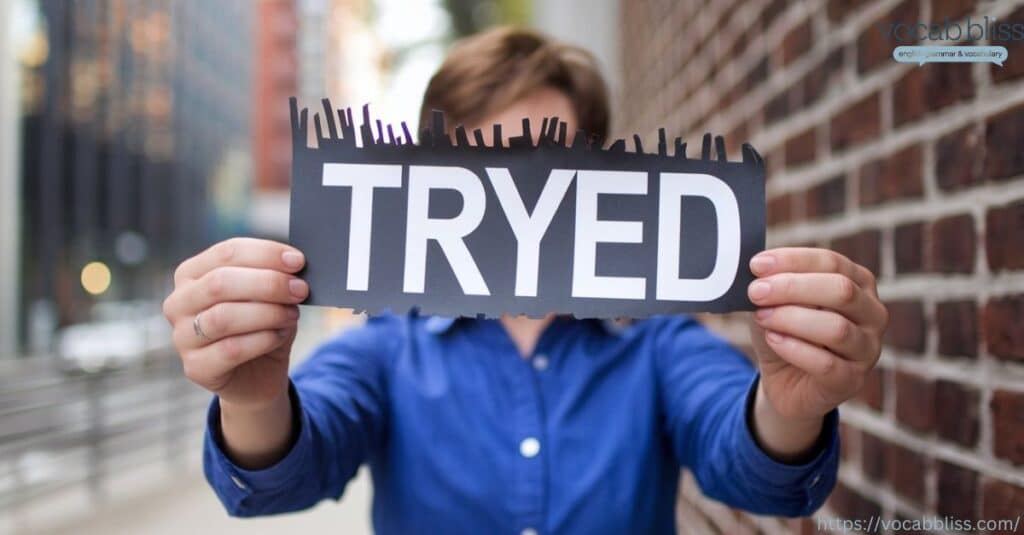
If you’re wondering how to spell “tryed”, you’re not alone. Many people mistakenly use “tryed” as the past tense of “try,” but the correct form is actually “tried”. In English, when a verb ends in a consonant followed by “y,” you change the “y” to an “i” before adding “ed.” This is why we say “tried,” not “tryed.” Following this basic rule of English grammar will help ensure your writing is both accurate and professional. Remember: “tried” is correct; “tryed” is a common misspelling.
FAQs: Tried vs Tryed
- Why is “tryed” incorrect even though it seems logical?
“Tryed” doesn’t follow English spelling rules. For verbs ending in “y,” the basic rule is to change the “y” to “i” before adding “ed” for the past tense.
- Are there any situations where “tryed” might be acceptable in informal English?
No. Unlike some slang spellings, “tryed” isn’t recognized in written or spoken English and would be seen as an error.
- What if my spell-check doesn’t catch “tryed” as incorrect?
Most spell-check tools should flag “tryed,” but it’s always helpful to double-check manually. Reading your writing out loud can also help you spot spelling mistakes.
Conclusion
Understanding the difference between “tried or tryed” may seem small, but it’s a valuable step in mastering English grammar and spelling. “Tried” is the universally accepted form as the past tense and past participle of “try,” while “tryed” is simply a
common misspelling. Remembering the “y to i before adding ed” rule will help you not only with “tried” but with many similar verbs in English.
Dive Deeper:
- Arial or Aerial? Sorting Out he Differences
- Happened or Happend: Is It This or That?
- Exception vs Exemption: What Sets Them Apart?
- Preform Vs Perform: What’s The Difference?
- Tweek vs Tweak: Clarifying the Difference and Usage

